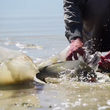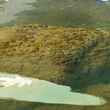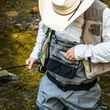If you’re living along the Eastern Seaboard, particularly in the Southeast or in the mid-Atlantic region, March Madness isn’t just about basketball. The redbuds and dogwoods are “almost there,” and Appalachian brook trout streams are eminently fishable, if not just a couple of weeks away from ideal.
Here in the West, we’re still measuring snow in the front yard in feet, but even so, there’s a slightly different bite to the air. Spring is threatening to actually happen. The days are longer. The sun seems more willing to push the gray away. For the optimists, there’s some thought starting the cold-tolerant seeds inside. For the pessimists, there’s always the NCAA bracket.
But no matter where you live in the U.S., March is a transition month. And for fly anglers, March is an underrated time of year. The longer days mean slightly warmer water, and a hopeful end to the giant floes of broken shelf ice that meander downstream and remind us all just how cold winter has been. It’s also a great time to spend at the vise. Here in the Rockies, the next six weeks or so of pre-runoff fishing can be really good. Along the Appalachian spine, trout anglers have at least a month long head start — it’s a great time to throw attractor patterns at winter-starved fish.
Here are some ideas for some March trout flies and how to start your fishing season hunched over the vise trying to craft some patterns that’ll bring trout out of their doldrums.
The Royal Coachman and its evolutionary variants
This storied fly pattern was first tied by English coachman Tom Bosworth, who steered coaches for three British monarchies (hence the name) in the early 1800s. Bosworth just called his creation the Coachman, and it’s undergone quite the evolution over the years.
In the late 1800s, a variation was tied from carpet thread and a tuft of fur from a golden retriever at a well-heeled fishing retreat on the Henry’s Fork in Idaho. Another was tied by a fly dresser in New York who took Bosworth’s original pattern and added in the red silk or floss band in the middle of the fly’s body. Later, the slicked back wing was jettisoned, and upright wings were added, making the fly a high-riding dry. Then, Lee Wulff swapped out the white duck feather for an upright calf tail, which made the fly float even better.
Since its snooty origins, the fly has spawned many variations ranging from the unsinkable Royal Wulff to the gaudy Royal Trude. Even the red silk that’s pinched between two tufts of peacock herl — the Royal Coachman’s trademark feature — has been swapped out for other colors, like orange, lime green or bright yellow. But the fly, even with all its variations, remains true to its stately origins. And right about now, a size 12 or 14 Royal Coachman floating over a Blue Ridge plunge pool looks pretty good to a wild brookie that’s been waiting for weeks for something to happen. What better way to begin the trout season than with a fly both you and the fish can see just fine.
The Griffith’s Gnat
Even if the days are longer here in the Rockies, it’s still winter. The rivers are still lined with snow and ice, even though the coming seasonal changes are telling. And winter dry-fly fishing in the Rockies is a small-fly endeavor, because the dominant surface insect is the venerable midge.
And there may not be a better midge pattern out there than Griffith’s Gnat. First tied by Michigander George Griffith (one of the founders of Trout Unlimited) in the mid-1900s, the “gnat” was a match-the-hatch pattern for late winter and early spring risers on Michigan’s trout streams. Since then, it’s become a go-to midge pattern no matter where anglers hunt for cold-weather trout. Here in eastern Idaho, I’ve enjoyed some great winter days on both the South Fork and the Henry’s Fork thanks to George’s old-school creation in sizes 18-20 —although, the winter “snowflies” on the Henry’s Fork can be as big as size 16!
The Blue-winged Olive soft hackle
From the east Tennessee tailwaters to the spring creeks of Paradise Valley and just about anywhere trout swim, the Blue-winged Olive mayfly is often the last mayfly hatch of the year, and then the first mayfly to pop in the spring. Where I live, this fly might very well be the dry fly I use most on my local rivers, from the South Fork to the Henry’s Fork and north to the Madison. That’s not because it’s a year-round fly (although, technically, I suppose it is). It’s because I generally fish the big water during the shoulder seasons of spring and fall when the crowds have abated and the rivers are in perfect condition for a walk-and-wade session. But, of late, I’ve taken to casting the soft-hackle version of the BWO, and I’m honestly having a lot more fun doing it.
Why? Trout will sip a dry fly. They will absolutely pummel a soft-hackle imitation as it swings and begins to move toward the surface. Also, by fishing the soft-hackle BWO, you eliminate the squints and the hooksets at nothing — it’s a more economical way to fish a pattern that spring trout love, and it’s largely a feel proposition, and not so much a sight-fishing proposition. You’re not glaring at the river trying to differentiate your size 22 imitation from all the damn naturals on the water.
The diminutive olive usually starts to pop on my local rivers when the springtime sun has been on the water for a bit, or on cloudy but warmer late-winter days. In the fall, it’s a fly that hatches best on gray, blustery days that bring the first sting of winter. In the east, particularly on tailwaters, the BWO really is a year-round fly — it can show up when Mother Nature decides to throw in a 40-degree day on the Delaware in January. If you’re fishing in the spring, you need to have a few size 20-24 BWO soft hackles in the box, because if there’s going to be a mayfly hatch, it’s going to be a baetis hatch, and that tiny soft-hackle swinger is what’s for dinner.
The Parachute Midge
You’re sensing a pattern here, yes? If you live and fish in the Rockies, March is a month for small flies, and the Parachute Midge is a great early season pattern for western rivers. Even in sizes 20 and smaller, it’s fairly easy to see as it floats among naturals and midge clusters. On eastern tailwaters, this is a go-to fly for rising trout all winter long. Even better, for a tiny fly, this is simple pattern (even for fat fingers like mine), and a reasonably adept tyer should be able to craft a dozen in an hour or so, with or without the tumbler of middle-shelf Irish whiskey at hand.
For anglers who don’t like to fish small flies, this is the small fly you should try. The tuft of white Antron pokes out of the water like a miniature spinnaker, while the fly’s body remains in the surface film, where trout are most likely feeding. If you’re searching for a winter fly that’ll both match the hatch and be visible on the water, this is your fly. At your local fly shop, the fly might not go by the Parachute Midge moniker. Instead, just look for midge patterns (usually small and dark) with a parachute finish, like Birchell’s Hatching Midge. Or it might be simply labeled as a “paramidge” or “para-emerger.” The idea, of course, is visibility. That’s your prime identifier.
The Sparkle Caddis Pupa
Yes, caddis flies hatch and flit around the rivers in the spring, even in the Rockies when snow is still piled up on the banks. But before these bugs hit the bank and crawl around in the willows before taking flight, they emerge from the river wrapped in little air bubbles. These bubbles help float the soon-to-be mature caddis to the surface.
When you look at tied Sparkle Pupa fly in, say, size 16 or 18, you might think the antron fibers ballooned around the fly’s body are supposed to imitate the “shuck” or the discarded casing of the hatching fly, but that’s not the case. That shed casing is somewhere at the bottom of the river. The antron around the fly’s body is meant to imitate those little air bubbles.
And, because this fly, during this stage in its life, is particularly vulnerable, it’s serious trout food. Tied in the right color and in the right size, it can be an absolute killer on an early season trout stream. I’ve fished Sparkle Pupas on the dead drift, but I really like to fish these emergers in slow-moving riffles, just as I would fish a soft-hackle fly.
Honorable mention: The Elk-hair Caddis
Full-on adult Caddis? In the spring? Yup, particularly if you’re fishing back East, where you have about a month’s head start on those who still can’t look out the window at the snow without muttering something that would have gotten our mouths washed out with soap years ago. Caddis are great early-season flies on Southern and Eastern tailwaters, even if they don’t hatch in thick clouds like they might later in the season. For many east-of-the-Mississippi anglers, caddis mark the first “big bug” hatch of the season.
But it’s not just an eastern thing. A few years back, while fishing a fork of the South Platte in Colorado in March, an in-earnest caddis hatch popped, and I and a couple of fishing buddies spent a solid hour with nippers and such, trying to turn perfectly good Adams patterns into flies that more closely resembled the light-brown caddis that were flitting around on the water. These were “winter caddis,” or a finger-net web-spinning caddis, about size 18. These caddis have been known to hatch and then crawl out western rivers and wander around on the snow.
A word to the wise on caddis: while it’s perfectly fine to use a full-blown adult version of the bug, consider going with crippled caddis instead. It hangs in the surface film, and offers a much easier meal for bigger trout who often won’t expend the energy needed to chase an energetic and unpredictable adult bug.
























![Instructors John Juracek [left] and Brant Oswald [right] from The School of Trout (photo: Tim Romano). school of trout instructors john juracek brant oswald](https://www.hatchmag.com/sites/default/files/styles/gallery_thumbnail/public/field/image/romano-0024.jpg?itok=X_had7Jf)






Comments